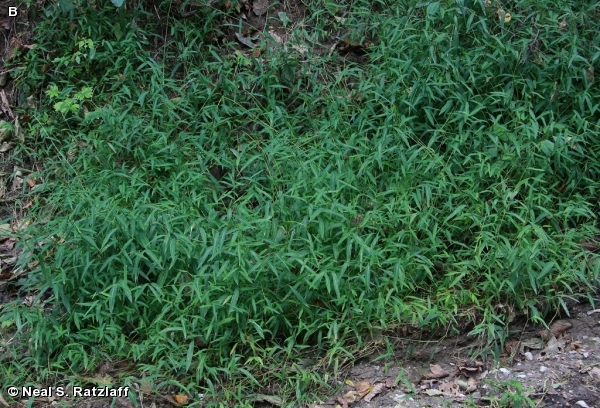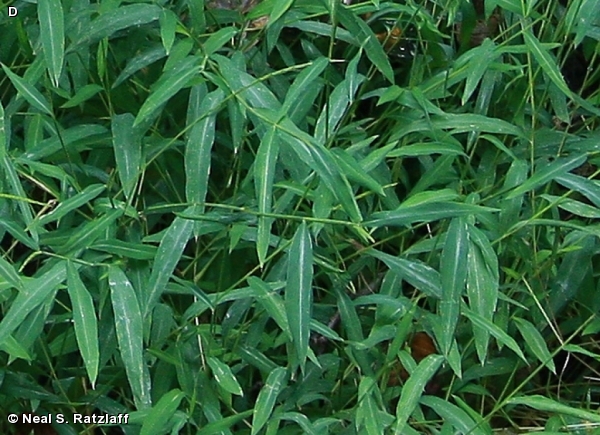
Japanese stiltgrass or Nepalese browntop is a non-native annual grass of Asian origin. It germinates from seed each spring, growing slowly during the summer producing many wiry, leafy branches. Lateral stolons which root at the nodes are the source of more leafy stems. The result is often a spreading monoculture of sprawling plants, especially in disturbed areas like paths and roadsides to which it seems especially well adapted. (B) Narrow, finger-like flowering stems appear in late summer reaching heights of 2 – 3 1/2 feet (A,C) producing small seeds (achenes) in September/October. The lance-shaped, pale green leaves are 3-4 inches long, up to 1/2 wide and possess a prominent, slightly asymmetrical, white midrib. (D)
This unwelcome addition to Fontenelle Forest’s flora was first noticed growing exuberantly along the edges of Gifford Road in a number of areas from just below the Aksarben building to the railroad tracks in the late summer of 2011. It has also been found in upland woods and a ravine next to Gifford Road.
Japanese stiltgrass was first documented in the state of Tennessee around 1919 and is believed to have been inadvertently introduced in packing material used to ship porcelain from China. It is now well established in much of the eastern US and has been slowly moving westward, this being the first reported occurrence in the state of Nebraska. Although areas of disturbance like roadsides, trails and field edges are the usual point of entry for this opportunist, it has been increasingly reported as a troublesome invasive in many natural areas. It is remarkably shade tolerant, reportedly growing well in situations of less than 5% sunlight. There is also good evidence white-tailed deer avoid this plant contributing to its success in areas where deer populations are excessive.
This plant bears a striking resemblance to one of our native woodland grasses, Whitegrass (Leersia virginica). Whitegrass leaves do not have the prominent whitish midrib characteristic of Japanese stiltgrass. The distinctive whitish hairs on the stem nodes of Whitegrass are also a distinguishing feature.
The content of NatureSearch is provided by dedicated volunteer Naturalists of Fontenelle Forest who strive to provide the most accurate information available. Contributors of the images retain their copyrights. The point of contact for this page is: Neal Ratzlaff.



